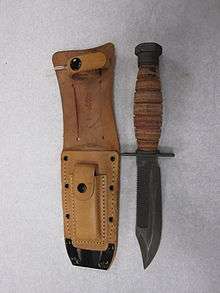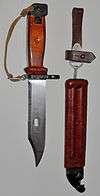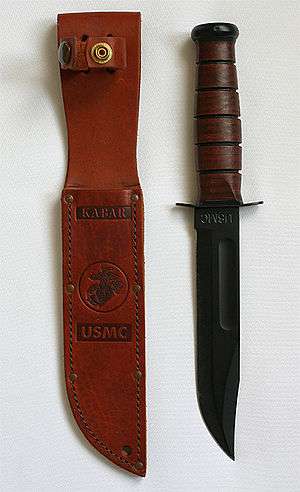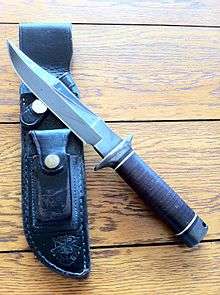Survival knife

Survival knives are knives intended for survival purposes in a wilderness environment, often in an emergency when the user has lost most of his/her main equipment. Military units issue some type of survival knife to pilots in the event their plane may be shot down. Survival knives can be used for trapping, skinning, wood cutting and other uses. Hunters, hikers, and outdoor sport enthusiasts use survival knives. Some survival knives are heavy-bladed and thick; others are lightweight or fold in order to save weight and bulk as part of a larger survival kit. Their functions often include serving as a hunting knife.[1] Features, such as hollow handles that could be used as storage space for matches or similar small items, began gaining popularity in the 1980s.[2] Custom or semi-custom makers such as Americans Jimmy Lile, Bo Randall, and Chris Reeve are often credited with inventing those features.[3][4]
Origins of the survival knife
Prior to the late 19th century, outdoorsmen and military personnel did not use knives that were notably different from the knives used by butchers. Blades were relatively thin and the handles were often no more than two wooden slabs riveted to the tang. Serrations appeared on knives in the 19th century for use as a wood saw or fish scaler.[2] Around the turn of the century, Webster L. Marble introduced the modern concept of the "hunting knife." These knives incorporated heavier blades, crossguards, and pommels. They very much resembled miniaturized Bowie knives. Case, Cattaraugus, and other cutlery manufacturers soon introduced similar knives of their own and it is from these that the modern concept of the survival knife is descended. These knives, along with machetes and bolos constituted survival knives as used by military, explorers, and outdoorsmen up through at least the 1930s.[5]
During WWII, survival knives were issued to aircraft crew, as it was a real possibility that these personnel might be shot down over wilderness or behind enemy lines. Lifeboats aboard naval vessels also frequently contained survival kits including knives. These knives varied in design from one branch of the service to another and from one nation to another. The majority of them were simply commercial knives purchased in bulk by the military. From the Vietnam-era and to present, purpose-built survival knives evolved.[6] One of Randall's designs which became a popular fighting knife for troops in Vietnam was the Number 14 "Attack" Model. During Vietnam, Randall received feedback from a Combat Surgeon in the US Army's 94th Medical Detachment named Captain George Ingraham. Ingraham's request was for serrations on the spine to cut through the fuselage of downed aircraft to rescue trapped personnel and a hollow handle to allow storage of survival gear. Randall made the changes and the result was the first of the modern survival knives.[5]
Some militaries (including the People's Republic of China, Great Britain, Germany, Soviet Union and United States) have redesigned the bayonet used with their issued rifle to include survival knife features. Historically, bayonets had functioned poorly as field knives, due to being designed primarily to turn a rifle into a thrusting weapon and only secondarily (if at all) to work as a field knife. The newer models function more acceptably for mundane tasks while remaining capable of being attached to the muzzle of a rifle.[7]
Features of a survival knife
Survival knives are designed for work such as setting traps, cutting branches and skinning animals. Most survival knives have fixed blades that are 10 cm to 20 cm (3.9 - 7.9 inches) long with a full thick tang. Survival knives made by Aitor, Lile, Parrish, Randall, or Reeve have hollow handles, which allow the user to store additional equipment in the handle. Some of these knives feature a compass in the cap. A hollow handle survival knife will have reduced strength and may break more easily when performing tasks such as chopping or batoning.
On some survival knives, the spine or back of the blade is flat; allowing it to make a good hitting platform when pounding it with a hard stick to aid in splitting wood. Other models such as Lile's and Parrish's feature a serrated spine or in the case of Rob Simonich's and Strider Knives, a band (strapping) breaker near the tip.
The handle material of survival knives differs from one to the next and is determined primarily by user preference. Handle materials can be hardened rubber, wood, bone (horn), aluminium, polymer, or even metal, such as stainless steel in the case of the Aitor Jungle King I, or tool steel as used in the Chris Reeve One-Piece line. Makers like Lile, Strider, and Parrish often wrap these metal handled knives with cord which can be used in survival situations and in daily use provides a more comfortable and reliable grip.
Aircrew Survival Egress Knife
The serrations seen on Aircrew Survival Egress Knife (ASEK) are intended to allow air crewmen to cut their way free through the relatively thin metal skin of a crashed helicopter or airplane.[2] Those knives that do include functional saw-teeth still suffer from lack of blade length, limiting the thickness of what can be cut when used as a saw.[2]
Gallery
-
Chris Reeve Knives hollow handled knives CRK Mark IV in the "One-Piece" line
-

U.S. M9 bayonet with clip-point blade, sawteeth along the spine, and can be used as a wire-cutter when combined with its steel scabbard
-

Jimmy Lile "Next Generation" First Blood
-

Aircrew Survival Egress Knife, line cutter and scabbard
-

The Gerber LMF II ASEK used to sever the 220 volt line; arrows point to the minor damage done to the cutting edge by the current.
-

Soviet AKM type II bayonet, multi-purpose knife and wire-cutter when combined with its scabbard.
-

Soviet AKM type II bayonet and scabbard in wire-cutter configuration.
-

USMC KA-BAR
-

SOG Knife
-
Glock Survival Knife (Feldmesser 81)
Examples of Survival Knives
- AKM bayonet introduced in 1959, has a Bowie style (clip-point) blade with sawteeth along the spine, and can be used as a multi-purpose knife and wire-cutter when combined with its steel scabbard.[8][9][10]
- Aitor Jungle King series. Hollow handled. All are stainless steel Bladed with stainless steel handle in JKI, Aluminum in JKII and Polymer in JKIII
- British Ministry of Defence Survival Knife (MOD4/MOD Carbon Steel Military Knife)
- Chris Reeve Knives hollow handled knives in the "One-Piece" line
- Cold Steel Bushman Series
- DPx Gear HEST- Hostile Environment Survival Tool designed by Robert Young Pelton
- Doug Ritter RSK Mk3 fixed blade Made by Shon Rowen. (Rowen Mfg.)
- ESEE Knives - Full line of USA Made Survival Knives made by Rowen Mfg.
- Fallkniven knives
- Gerber Legendary Blades - Bear Grylls
- Glock Survival Knife (Feldmesser 81)
- Grohmann Outdoor Knives
- Hackman Finland Stainless Hollow Handle Knife
- Hillknives Holland, makes the S.O.K. Special Operations Knife for Dutch Defence
- Ka-Bar Knives
- Kizlyar Cold steel - DV-2 Fixed Blade Survival Knife
- Klotzli knives - Model 5
- KRM-Performance - The 33rd
- Martin Knives - MCEII, MCEII-7", SURV9, Apparo
- Mora knives
- Randall Made Knives - Model 17 "Astro", Model 18 "Attack and Survival"
- Ray Mears- Woodlore Fixed Blade
- Robert Parrish - 8" "Attack Survival " and the Model 36
- Robert Young Pelton designed the DPx H•E•S•T (Hostile Environment Survival Tool) sold by ESEE Knives and made by Shon Rowen (Rowen Mfg.)
- SOG Knife - Team Leader, SEAL Team, and SEAL Pup, SEAL Pup Elite, Tech Bowie
- Swamp Rat Knives - CampTramp, Howling Rat, Ratweiler
- TOPS Knives
- Wilkinson Sword - Survival Knife/Dartmoor Survival knife (design of the mid 80's)
- W.G. Stegner - Fixed Blades
See also
References
- ↑ McDougall, Len (2001). The Field & Stream Wilderness Survival Handbook. The Lyons Press. pp. 76–90. ISBN 978-1-58574-356-8.
- 1 2 3 4 Jackson, Mark (1987). "Survival Knives". Black Belt (Active Interest Media, Inc.) 25 (2): 40–48.
- ↑ Lang, Bud (1992). "Chris Reeve Knives We Put Two Of His One-Piece Knives To The Test With Unexpected Results". Knives Illustrated: 64–66.
- ↑ Hunt, Robert E. (2006). Randall Knives: Rare, Unique, & Experimental. Turner Publishing. pp. 143–147. ISBN 978-1-59652-217-6.
- 1 2 Pacella, Gerard (2002). 100 Legendary Knives. Krause Publications. p. 224. ISBN 0-87349-417-2.
- ↑ Southworth, Samuel A.; Stephen Tanner (2002). U.S. Special Forces: A Guide to America's Special Operations Units-The World's Most Elite Fighting Force. Da Capo Press. pp. 113–114. ISBN 978-0-306-81165-4.
- ↑ Lewis, Jack (2007). The Gun Digest Book of Assault Weapons: From Bayonet to Multi-tool. Gun Digest Books. pp. 221–224. ISBN 978-0-89689-498-3.
- ↑ Kalashnikov Bayonets. The Collectors' Guide to Bayonets for the AK and Its Variations. by Martin D. Ivie. Texas Diamond Eye Publications 2002. page 1-5
- ↑ http://worldbayonets.com/Misc__Pages/ak_bayonets/ak_bayonets.html
- ↑ how to use the wire cutter on an akm /ak 47 bayonet. YouTube (2009-07-16). Retrieved on 2011-09-27.
External links
| Wikimedia Commons has media related to Survival knives. |
| Look up survival knife in Wiktionary, the free dictionary. |